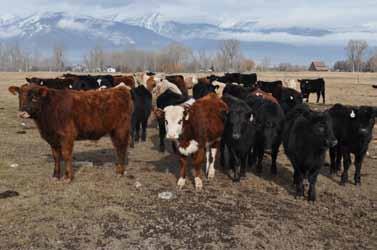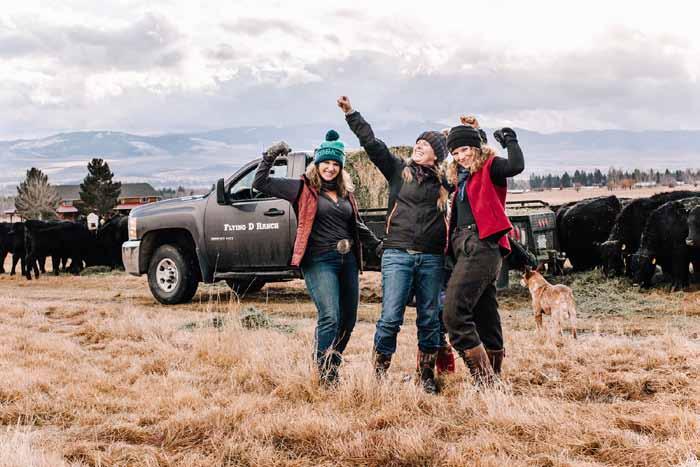
9 minute read
Agriculture Heritage Notebook
Page 18 - Agriculture Magazine, September 2020
The Bitter Root Cultural Heritage Trust works in partnership with families, neighborhoods and communities to restore historic structures, bring back traditional events and celebrations, encourage interpretation and affirm cultural values. The Heritage Trust provides an article for each edition of Agricultural Magazine, highlighting the Bitterroot Valley’s agricultural history and heritage.
Advertisement
Story & photos WENDY BEYE
My plan was to interview brothers Tom and Cliff Ruffatto in May, but mechanical failures and COVID-19 restrictions threw their respective monkey wrenches into that plan. Finally, on a miraculously smoke-free August day with no rain in sight, I drive up Bass Creek Road to visit the loquacious Ruffatto boys. Though I am a bit early for my appointment with Tom, he is waiting for me on his shaded driveway, anxious to share his family story.
The farmhouse, barn, and outbuildings are all in good repair, and flowers brighten the yard. The first thing Tom wants to show me is the bunk
Agriculture Magazine, June 2019 - Page 19
Ruffatto Barns Feronato Family photo house that shares space with half a dozen huge Ponderosa pines soaring into the blue sky.
Next to the bunkhouse is the old milk shed, and between the two buildings a four-foot diameter pine fills the space, pushing up on the bunkhouse roof. Tom points to the foundation and says, “That tree has raised the building a foot off its foundation!” He may someday need to build a ladder to access the door. I’m pretty sure the tree will never feel the bite of a chainsaw.
We stroll toward the barn that is perched above the Bass Creek floodplain. It has a good metal roof to protect the interior against rain and winter snow. Tom claims it needs some paint, but it still looks pretty fresh to me. The double doors slide open without much effort, and the interior is dry and clean, smelling of cut lumber and hay. Several sets of draft horse harness hang on the walls. The horses were still in use as Tom grew up, and he continued to enjoy working with the animals until

recently. There are boxes of dinner plate-sized horseshoes, a giant blacksmith anvil, and a basin full of linseed oil for soaking harness leather in a workroom off the main barn alley.
On the ground floor near the west door is a wooden grate that covers a cavernous hole. Next to it are several hollow wooden columns with openings exposing metal scoops mounted on rubber belts. I look up to the ceiling and see pulleys and shafts. Tom says grain was dumped through the grate, then picked up by the moving grain scoops and sent to the loft where there were four grain bins for storage. An engine drove the pulleys and shafts that moved the scoop belts. From the loft, the grain could be sent back downstairs through a chute, mixed with supplements, and bagged for feed.
As we walk up the stairs to the loft, he points at an upside down clear teardrop globe mounted on the wall. “This is a fire extinguisher,” he says. “This

Homesteader Trexler’s first barn
Page 20 - Agriculture Magazine, September 2020
little black cap on the neck pops off as the liquid heats when there is a fire. Then the retardant sprays out.” The globe can also be removed from the bracket and thrown onto a fire if someone is present in the barn when a fire starts. Fortunately, he’s never had to test the system. He says someone must have made the rounds in the Bitter Root, selling the idea and the equipment, perhaps following in the tracks of the lightning rod salesman.
The loft contains more old harness leathers, which are obviously unusable, but Tom says he uses the buckles when making repairs on other gear. We go back outside, and walk down toward the creek to look at the original barn built by homesteader Trexler. It’s built of logs and has a tin roof that he says is stamped “1910” on the underside of the sheets. The metal has a high lead content and is very malleable. He says the building used to be two stories, but is now only one level, and is useful as a shelter for livestock.
Tom and Cliff’s grandfather, Mario Feronato and his wife Mary moved to Montana in 1917, their travel expenses paid by American Crystal Sugar Company in exchange for two years of work in the sugar beet fields in the valley. The family came from Colorado, traveling in a railway boxcar loaded with all their household furnishings and the family milk cow.
Trexler’s homestead was owned at the time by Missoula banker George Brooks, who took it over when mortgage payments ceased. Trexler came to the Bitter Root Valley hoping to strike it rich with the gold mine he claimed further up Bass Creek Canyon. The Feronato family managed the ranch for the bank until they could afford to buy it. The barn was built by local carpenter E.A. Neeley in the late 1920s or early 1930s. Trexler worked for the Feronatos during the winter months, borrowing horses from them to go work his gold mine when weather turned warmer. He had a cabin at the mine with “running water” - a creek that passed under a corner of his cabin all summer.
Mario and Mary had five children - all girls - and in a twist of fate, two of the girls married Ruffatto brothers, John and George.
John and George both served in the military during WWII. John met Frances Foronato on a
A ponderosa pine lifting bunkhouse off foundation.


Hay bales to help anchor west wall of the barn.
Grandpa’s whiskey and brandy bottles.


A blacksmith’s anvil.
Agriculture Magazine, September 2020 - Page 21
train from Stevensville to Oakland in 1944, where she had landed a U.S. Naval Auxiliary Air Station job. He proposed, married her in 1945, and went to school to become a lawyer in Missoula. George moved to the Bitter Root after the war ended from the family home in Brockton, Montana (near Glasgow). He had ten brothers and sisters, and no hope of inheriting enough land to ranch there.
George married Loretta “Babe” Feronato after working on her father’s ranch as a hired hand for a few years. The brothers left some tragedy behind in Brockton. According to the Glasgow Courier of July 5, 1918, two Ruffatto sisters, Josie, age 16, and Marie, age 10, were wading in the Missouri River with a young married friend, Mrs. Carl Larson, age 20. One sister stepped off the sand- bar into a deep hole, and the other girls tried to save her. None could swim, and all three drowned. Six months later, Mrs. Larson’s husband Carl, died in the influenza epidemic (Plentywood Producer’s News December 17, 1918).
Tom’s house was built around the original farm- house erected by Trexler. He tells me he had to raise the whole house, move it aside, build a new foundation, and move it back into place. The only piece lost was the original chimney. The new foun- dation is built from “Bitter Root potatoes,” those round ball bearing granite rocks produced by gla- ciers moving out of the mountain range along the west side of the valley. There are plenty available on the ranch.
Cliff Ruffatto comes rumbling through the ranch yard on a bale wagon loaded with hay as I’m fin- ishing up my conversation with Tom. He tells me I can head down the road to his barn and he’ll follow shortly. His property came into the family when it was purchased from Ed O’Hare by George Ruffatto.
O’Hare lived in Stevensville, raising prizewinning Beau Donald Herefords from the line founded by Curtice Martin who lived just south of the Bass Creek ranch. The First Annual Missoula Hereford Association sale in February, 1949, lists Feronato and O’Hare bulls, and the Feronato Ranch was featured on a valley Hereford tour that year. Cliff later tells me that he had to say good- bye to the last of his old-style horned Hereford cows this year. The old cow was the product of a
Page 22 - Agriculture Magazine, September 2020
great genetic line that is now no longer obviously visible on the ranch.
Cliff’s barn was built in about 1930, according to the Montana Appraisal Office. Its style of construction indicates that the carpenter was not E.A. Neeley, and it was built as a dairy barn rather than for housing draft horses. Wooden stanchions remain on the north side of the main alleyway. It has been lovingly cared for, and the loft was the site for Ruffatto brother basketball skirmishes as well as the wedding reception for Cliff and his wife Chris. They live in a cozy house that was built around a milk parlor. Chris is a talented fabric quilter, and crafted the painted “barn quilt” fastened to the east end of the barn. Cliff explains that the stack of straw bales piled next to the west wall in the loft is to keep the wall from tilting in when strong west winds howl out of Bass Creek Canyon. He shows me one of the mangers on the main floor that contains empty whiskey and brandy bottles stashed there by his grandfather, looking like large eggs in a hen’s nest.
I was unable to do my usual historic ownership records research because the Ravalli County Recorder’s Office records room was off-limits to the public. Both Tom and Cliff have an old hand-tinted panoramic photo of the Feronato Stock Farm that shows four of the girls posing by a 1940s vintage car, the barn (then painted white) on the Trexler homestead, their father Mario on a horse, and a herd of Hereford cattle. The Feronatos and the Ruffattos added land to their ranches whenever they could, and the Ruffatto Land and Cattle Company is a big operation by Bitter Root standards. It keeps Tom, Cliff, and their family busy working on it year around, maintaining its agricultural heritage.
The west end of the Ruffato barn.


An old box of fire extinguisher globes.
Financing availab le O. A . C.

22-105HP to choose from

Backhoe rebate end s 6 / 30/ 20









